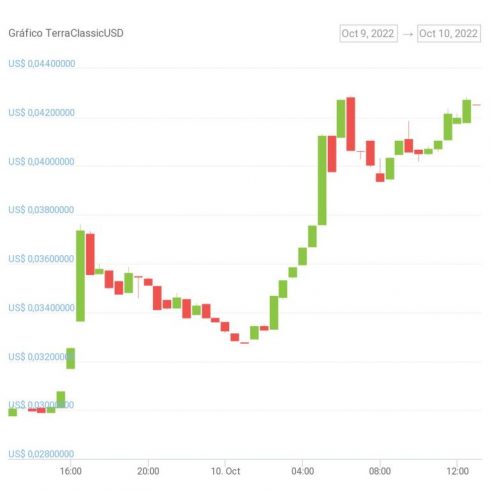All is not lost when it comes to cryptocurrencies. After all, even those considered “dead” can revive. And that seems to be the case for the assets associated with the Terra network, which collapsed in May of this year. While LUNC (Terra Classic) sketched a reaction, jumping about 3% in the last 24 hours, after Binance burned another 3 billion tokens; the USTC stablecoin (which should be worth $1) is up over 43% in the last 24 hours alone – as unusual as that might be for an asset designed to be stable. At the time of writing this article, the digital asset is trading at US$0.042 (or R$0.22). As can be seen, the price is still well below the dreamed US$ 1. But the recovery is still expressive.
USDT digital currency price chart for the last 24 hours. Source: CoinGecko
Proposal for USTC to recover the ‘peg’
The appreciation of the stablecoin coincides with the publication of a proposal to recover the “peg” of the stable digital currency. That is, its one-to-one parity with the US dollar, lost on the 8th of May and never recovered. In the proposal, Tobias Andersen proposes, among other things, to reduce the debt that was accumulated in May during the event he called the “black swan”. For this, the blockchain engineer suggested creating a process to recapitalize the stablecoin. His idea is to use measures similar to quantitative easing (QE). It is a monetary stimulus strategy used in the traditional market that consists of creating significant amounts of “new money”. Or use quantitative tightening (QT) – when the central entity reduces its ownership of financial assets. As Andersen explained, in May 2022, Terra Classic witnessed a ‘black swan’ event. This collapse resulted in Terra’s “bankruptcy” through what he called a “vicious death spiral.” However, something remained of that, he said: “Luckily, we are left with a key asset that, if nurtured carefully, could help bring about one of the most significant economic recoveries in modern history. And you may not have guessed that this asset is the people reading this document, the so-called ‘diamond hands’ investors who bet on the future of our platform,” he wrote.
USTC can recover?
In an extensive post, Andersen explained his plan that I consider quantitative easing (QE) first. However, as he himself pointed out, there are some problems with using this technique, including a “$10 billion debt mountain”. In the face of difficulties, Andersen presents another “much more painful” option, that of quantitative tightening (QT), which includes burning taxes. According to him, this formula would lead to a significant reduction in the circulating supply of USTC and LUNC. “At the same time, it would put both ‘value networks’ on a sustainable path to a lasting economic recovery,” he said. Finally, with respect to the USTC’s re-fixation proposal, Andersen says that an “anti-fragile” market maker system needs to be established. The idea, according to the engineer, is to encourage new businesses to leverage the infrastructure of the existing platform in a way that induces positive growth in the network.

